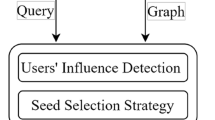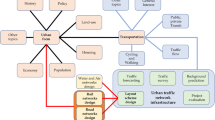Abstract
When studying scalability in ad-hoc networks, most works present experimental results for a limited number of nodes (100–200). Various “explicit” clustering techniques have been proposed to improve scalability, obtaining successful sessions for 400–800 nodes. However, explicit clustering may damage the performance, e.g., cause session breaks due to fast movements of cluster heads. An alternative to explicit clustering is the use of algorithms that are “naturally clustered”, i.e., arrange the nodes in dynamic hierarchical structures. In this work, we study the effect of explicit clustering by comparing an advanced version of the Ad Hoc Distance Vector Algorithm (AODV) with the Metrical Routing Algorithm (MRA) that possesses the natural clustering property. We cover fundamental aspects of scalability and experimentally prove the superiority of implicit clustering over explicit clustering. In particular, we consider heterogeneous theaters with several types of transmitters including personal, car-mounted, helicopters and a Geostationary (GEO) satellite. Natural clustering is more effective in heterogeneous theaters as the more powerful transmitters can serve as cluster heads. A formal bound based on general probabilistic assumptions shows that all existing ad-hoc algorithms cannot scale infinitely, thus rendering scalability as an experimental issue.
Similar content being viewed by others
References
Xu, K., & Gerla, M. (2002). A heterogeneous routing protocol based on a new stable clustering scheme. In Proceedings of MILCOM 2002 (Vol. 2, pp. 838–843). Available from http://www.cs.ucla.edu/NRL/wireless/uploads/kxu_milcom02.pdf.
Lihui Gu, D., Pei, G., Ly, H., Gerla, M., & Hong, X. (2000). Hierarchical routing for multi-layer ad hoc wireless networks with UAVs. In Proceedings of Milcom.
Li, J., Hass, Z. J., & Sheng, M. (2002). Capacity evaluation of multi-channel multi-hop ad hoc networks. In TCPWC.
Blending-Royer E.M. (2002) Hierarchical routing in ad hoc mobile networks. Wireless Communication & Mobile Computing 2(5): 515–532
Gu, D. L., et al. (2000). UAV-aided intelligent routing for ad-hoc wireless networks in single-area theater. In IEEE WCNC. Available from http://citeseer.ist.psu.edu/gu00uav.htm.
Ben-Asher, Y., Feldman, S., & Feldman, M. (2006). Ad-hoc routing using virtual coordinates based on rooted trees. In IEEE SUTC, Taiwan.
Perkins, C. E., & Royer, E. M. (1999). Ad hoc on demand distance vector routing. In Proceedings of the 2nd IEEE Workshop on Mobile Computing Systems and Applications (pp. 90–100), New Orleans, LA, February 1999.
Rubin, I., Behzad, A., Ju, H., Zhang, R., Huang, X., Liu, Y., & Khalaf, R. (2004). Ad hoc wireless networks using mobile backbones, Chap. 9. In R. Ganesh, S. Kota, K. Pahlavan, & R. Agust (Eds.), Emerging location aware broadband wireless ad hoc networks (pp. 141–161). Dordrecht: Kluwer Academic Publishers.
Villasenor-Gonzalez L., Ge Y. (2005) HOLSR: A hierarchical proactive routing mechanism for mobile ad hoc networks. IEEE Communication Magazine 43: 118–125
Rhee K.H., Park Y.H., Tsudik G. (2004) An architecture for key management in hierarchal mobile ad hoc networks. Journal of Communications and Networks 6(2): 156–162
Xu, K., Hong, X., Gerla, M., Ly, H., Gu, D. L. (2001). Landmark routing in large wireless battlefield networks using UAVs. In Military communications conference 2001. Communications for network-centric operations: Creating the information force. IEEE (Vol. 1, pp. 230–234). Available from http://www.cs.ucla.edu/NRL/wireless/uploads/kxu_milcom01.pdf.
IEEE Computer Society. IEEE 802.11 standard, IEEE standard for information technology.
Author information
Authors and Affiliations
Corresponding author
Rights and permissions
About this article
Cite this article
Ben-Asher, Y., Feldman, S., Feldman, M. et al. Scalability Issues in Ad-Hoc Networks: Metrical Routing Versus Table-Driven Routing. Wireless Pers Commun 52, 423–447 (2010). https://doi.org/10.1007/s11277-008-9636-5
Published:
Issue Date:
DOI: https://doi.org/10.1007/s11277-008-9636-5




